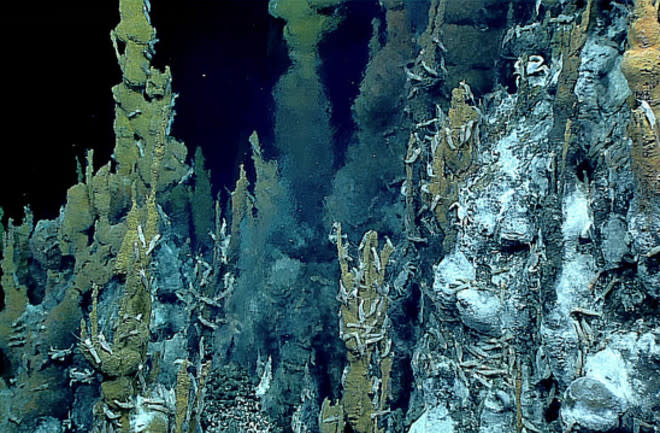- Science News
- Featured news
- Likely energy source behind first life on Earth found ‘hiding in plain sight’
Likely energy source behind first life on Earth found ‘hiding in plain sight’
By Jessica Wimmer and William Martin

A deep-sea hydrothermal vent. According to one theory, the first life on Earth arose at vents like these.Credit: NOAA Office of Ocean Exploration (CC BY-SA 2.0)
Life on Earth arose roughly four billion years ago. How it arose, and from what energy source, is of interest to everyone, because we humans like to know where we come from. The team of Prof William Martin at the University Düsseldorf’s Institute of Molecular Evolution investigates early evolution. In a recent paper in Frontiers in Microbiology, they argue that the source of energy required at life’s origin has been hiding in plain sight: under the environmental conditions at deep sea hydrothermal vents, hypothesized to have been the sites where life on Earth originated, the central biosynthetic reactions of life do not require an external energy source. Rather, these core metabolic reactions release energy all by themselves as long as H2 and CO2 are in supply. The scientists thus link life's biochemical beginnings to naturally occurring geochemical reactions. Here, corresponding author Ms Jessica Wimmer and Prof Martin explain their findings for a wider audience.
There are many competing theories for how and where life arose. Although the debates can sometimes be fierce, everyone has to agree on one point: there had to be a source of energy at origins because without energy release, no chemical reactions will go forward, so says the second law of thermodynamics. To find out what source of energy might have pushed the first reactions of life forward into the onset of the first cells, we recently took a closer look at metabolism itself to see if cells had preserved traces of life's first energy source in their most conserved biochemical reactions. By studying the process of energy release in the reactions that cells use to make the building blocks of life, we uncovered new insights into life's origin. The findings, published in Frontiers in Microbiology reveal that under the environmental conditions of hydrogen-producing hydrothermal vents, the energy for the origin of life could come from life itself.
Specifically, we looked at core metabolism, the reactions that generate the basic building blocks of life. For this, we identified a set of roughly 400 ancient reactions that cells use to synthesize the 20 amino acids of proteins, the four bases of genes, and the 18 vitamins that cells need to make those 400 reactions work. Those core chemical reactions are conserved across all microbial lineages, hence they were present in the last universal common ancestor of all life, LUCA. They provide a window into the source of building blocks, but also the source of energy at origins.
Reactions of H2 and CO2 powered the origin of metabolism
Scientists have pondered all kinds of different energy sources at the origin of life, from ultraviolet light, radioactivity, and meteorite impacts to lightning. The problem is that real cells don't use any of those energy sources: they use chemical energy. The simplest form of chemical energy is that used by ancient and primitive lineages alive today that not only live off the reaction of H2 and CO2 — acetogens and methanogens — but that also use the energy in H2 and CO2 to synthesize cell mass. That led us to the question: What are the sources of chemical energy in the reactions of metabolism itself, the reactions that make amino acids, bases and co-factors from H2, CO2 and ammonia? The standard answer from a textbook standpoint would be ATP, adenosine triphosphate, the universal energy currency in all cells. ATP helps sluggish reactions in metabolism to go forward. But ATP is not a primordial metabolic compound, rather it is highly derived. In other words, ATP is a product of metabolism, not its starting point. We found that only 80 of the 400 reactions at the heart of biosynthetic metabolism require ATP, the other 320 do not. What drives those 320 reactions forward?
They go forward all by themselves because they release energy. We showed this by calculating the changes in Gibbs free energy across the reactions of central metabolism using available bioinformatic tools. When we calculated the value of Gibbs free energy for biosynthetic reactions across a range of different environmental conditions, we found that under the conditions of H2 producing hydrothermal vents — 80 to 100°C, pH 7 to 10, and a small amount of H2 as a source of electrons to convert CO2 into organic compounds — up to 97% of the chemical reactions that make the building blocks of life release energy. This fits well with recent findings by our colleague Dr Martina Preiner that pyruvate, the most central compound of biosynthetic metabolism in all cells, is formed overnight from H2 and CO2 in chemical reactors that recreate hydrothermal vent conditions in the laboratory. The synthesis of pyruvate from H2 and CO2 is the backbone of carbon and energy metabolism in the most primitive microbes, acetogens, and methanogens. In modern microbes, the reaction from H2 and CO2 to pyruvate requires 10 enzymes and 10 complicated co-factors (vitamins). In the laboratory, the reaction between H2 and CO2 to pyruvate goes forward if we just add mineral catalysts that naturally occur in hydrothermal vents. The reaction goes forward because it releases energy. This underscores the principle that the chemical reactions of metabolism are older than the proteins that catalyze them and that minerals preceded proteins as catalysts in evolution. Taken together, such findings help to explain how something as complicated as metabolism could have evolved.
Metabolism and life arose in the dark
The new findings uncover a natural tendency of metabolism to unfold under the environmental conditions of H2 producing submarine hydrothermal vents. No light or other source of radiation was required. Just H2 and CO2 in the dark. Our calculations indicate whether a reaction can go forward. Whether or not reactions will go forward depends on the presence of catalysts, which are abundant at H2 producing hydrothermal vents. The role of inorganic catalysts in early metabolic evolution is currently being studied by many groups as they help to bridge the gap between chemical reactions on the early Earth and enzymatic reactions as they occur in modern cells. One important piece of evidence for the nature of energy at origins has been hiding in plain sight: the central hub of reactions that make up the life process itself. The driving force behind metabolic energy release ultimately traces to a steady geochemical interface of H2 and CO2, a chemical mixture that is brimming with energy like a fresh battery. That energy is released in the 400 reactions comprising the core of a universally conserved set of biosynthetic pathways, a thermodynamic imprint of the environment at which life arose, uncovering surprising clues about the source of energy at origins.

Jessica Wimmer and Prof William Martin. Credit: Dr Verena Zimorski
If you have recently published a research paper with Frontiers and would like to write an editorial about your research, get in touch with the Science Communications team at press@frontiersin.org with ‘guest editorial’ in your subject line.
REPUBLISHING GUIDELINES: Open access and sharing research is part of Frontiers’ mission. Unless otherwise noted, you can republish articles posted in the Frontiers news blog — as long as you include a link back to the original research. Selling the articles is not allowed.







